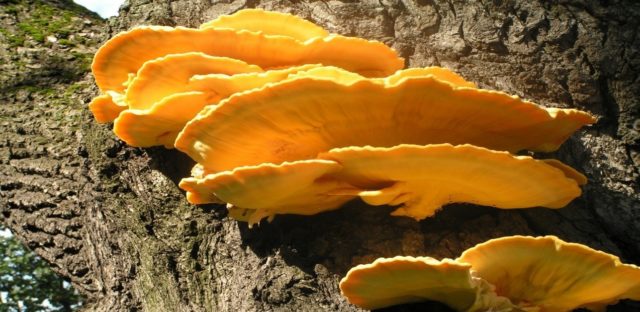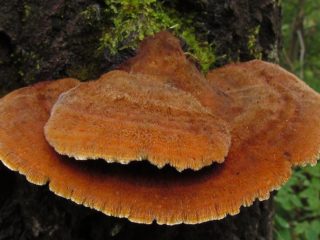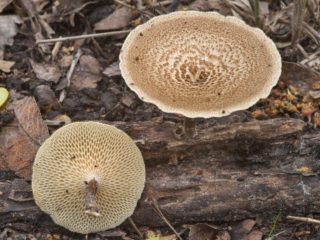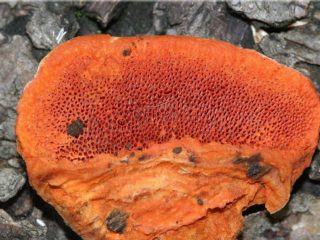Content
The sewing polypore (Phaeolus schweinitzii) is a representative of the Phomitopsis family, genus Pheolus. This species also has a second, no less well-known name – feolus sewer. In most cases, the fruiting body of this specimen is presented in the form of a cap; in some cases, there is a small stalk that holds several caps at once.Below is detailed information about the sewing polypore: description of appearance, habitat, edibility and much more.
Description of the tinder fungus Schweinitz

In older specimens, the color of the cap becomes dark brown, close to black.
The shape of the cap can be different - flat, round, funnel-shaped, semicircular, saucer-shaped. Its thickness is about 4 cm, and its size can reach up to 30 cm in diameter. In young mushrooms, the surface is bristly-rough, pubescent, felt, and at a more mature age it becomes bare. At the initial stage of ripening, it is colored in grayish-yellow shades, and over time it acquires a brown or rusty-brown color. Initially, the edges of the cap are slightly lighter than the general background, but after a while they become comparable to it.
The hymenophore is tubular, descending, yellow in color at the initial stage of maturation; with age it acquires a greenish tint, and in mature mushrooms it becomes dark brown. In young specimens, the tubes are round with jagged edges, up to 8 mm long, and gradually become tortuously patterned. The leg is either thick and short, tapering downward, or absent altogether. As a rule, it is located in the center, has a brown color and a fluffy surface.
The pulp of the tinder fungus is spongy and soft, in some cases it becomes flabby. In adulthood it is tough, hard and fibrous. When the mushroom dries out, it becomes light and very brittle. It can be colored in yellow, orange or brown shades. It has no pronounced taste or smell.
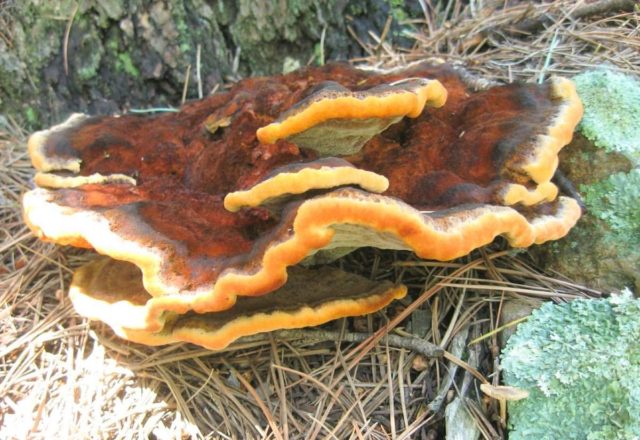
Feolus Schweinitz is an annual mushroom that differs from its relatives in its rapid growth
Where and how does it grow
The development of the Schweinitz polypore occurs from June to September, but this specimen is found in autumn and winter, depending on the climatic conditions of a particular region. Most often located in the European part of Russia, Western Europe and Western Siberia. This species prefers to grow in temperate and northern regions of the planet. As a rule, it lives in coniferous forests and bears fruit on trees, mainly pine, cedar, and larch. In addition, it can be found on plums or cherries. Settles on tree roots or near the base of trunks. It can grow singly, but most often the mushrooms grow together in groups.
Is the mushroom edible or not?
The Schweinitz tinder fungus belongs to the category of inedible mushrooms. Due to the particularly hard pulp, it is not recommended for consumption. In addition, this specimen does not contain any nutritional value, since it has no pronounced taste or smell.
Doubles and their differences
The sewing polypore has external similarities with the following forest gifts:
- Tinder fungus - inedible specimen. As a rule, the cap is much smaller in size - no more than 20 cm in diameter, and its color varies from grayish to brown. Another distinctive feature is the cushion-shaped shape of the fruiting bodies.
- Pfeiffer tinder fungus – has a hoof-shaped shape and white pores. The surface of the fruiting bodies is divided into orange-brown concentric zones.In winter, this mushroom is covered with a waxy yellow film. Not edible.
- Sulfur-yellow tinder fungus belongs to the category of conditionally edible mushrooms, but experts do not recommend eating it. The species in question is similar to its counterpart only at a young age. A distinctive feature is the bright color of the fruiting bodies and the release of watery yellow drops.
- Pink tinder fungus - an inedible mushroom of unusual color, settles in coniferous forests. The fruiting bodies are perennial, hoof-shaped, less often imbricated. At the initial stage of development, the surface of the cap is pink or lilac, becoming brown or black with age. A distinctive feature from the tinder fungus is the pink hymenophore.
How does the tinder fungus affect trees?
The species in question is a parasite that connects to wood with mycelium and causes brown root rot. The sewer tinder fungus can be located not only on wood, but also on the soil, settling not far from it. The disease process extends over several years, since the rot increases by about 1 cm per year. At the initial stage of decay, a strong smell of turpentine is noticeable, and in the final stage of damage, the wood becomes brittle and falls into separate pieces. Rot is distributed along the trunk in spots or stripes, on average it affects a tree up to 2.5 m high.
An infected tree can be distinguished by the presence of parasitic fungi and the tilt of the trunk, which reaches 60 degrees. This phenomenon occurs due to the death of the root system. Also on a diseased tree you can notice cracks in the butt part, where films of the mycelium of a light brown color are visible. When tapped, the infected tree makes a hollow sound.
Conclusion
The sewing fungus is a parasitic fungus that is located on coniferous wood, thereby causing colossal harm. Despite the fact that this type is not applicable in the culinary field, it is used in the industrial sector.


